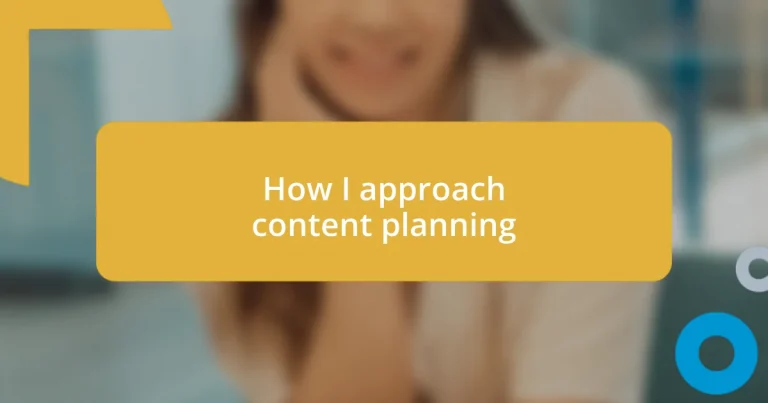Key takeaways:
- Understanding your target audience is crucial for relevant content; a misjudgment can lead to wasted efforts.
- Setting clear, actionable content goals enables better organization and motivation, while regular reassessment allows for flexibility.
- Utilizing effective tools and regularly reviewing performance helps optimize content strategies based on audience feedback and data insights.
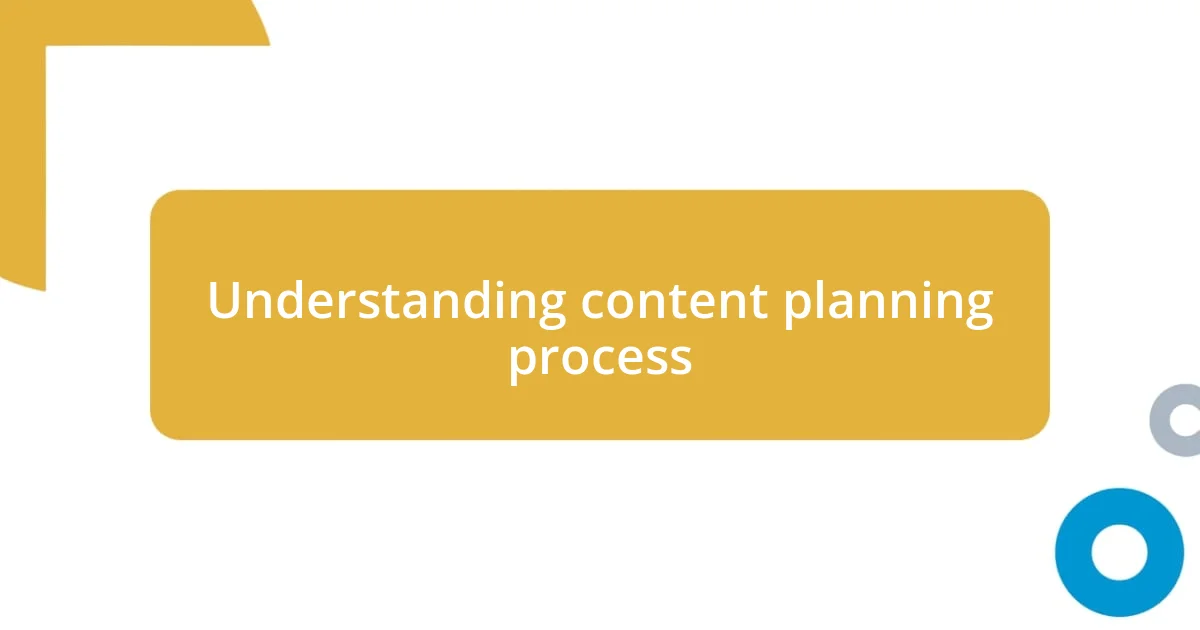
Understanding content planning process
Content planning is like setting the map before a road trip; without a clear route, it’s easy to get lost. When I first started, I often jumped straight into creating, only to realize later that I had missed important milestones along the way. It’s a humbling experience—can you relate?
Understanding the process involves breaking it down into actionable steps. For me, it starts with brainstorming ideas that resonate with my target audience. I remember a time when I thought I understood my audience’s needs but realized through feedback that I was heading in the wrong direction. This taught me that listening to my audience is just as crucial as generating content ideas.
As the plan takes shape, I prioritize what steps to take and set realistic timelines. I often find myself reflecting on past projects to gauge what worked and what didn’t. Have you ever found a treasure trove of insights in past experiences? It’s a powerful way to refine my plans and make more informed decisions moving forward.
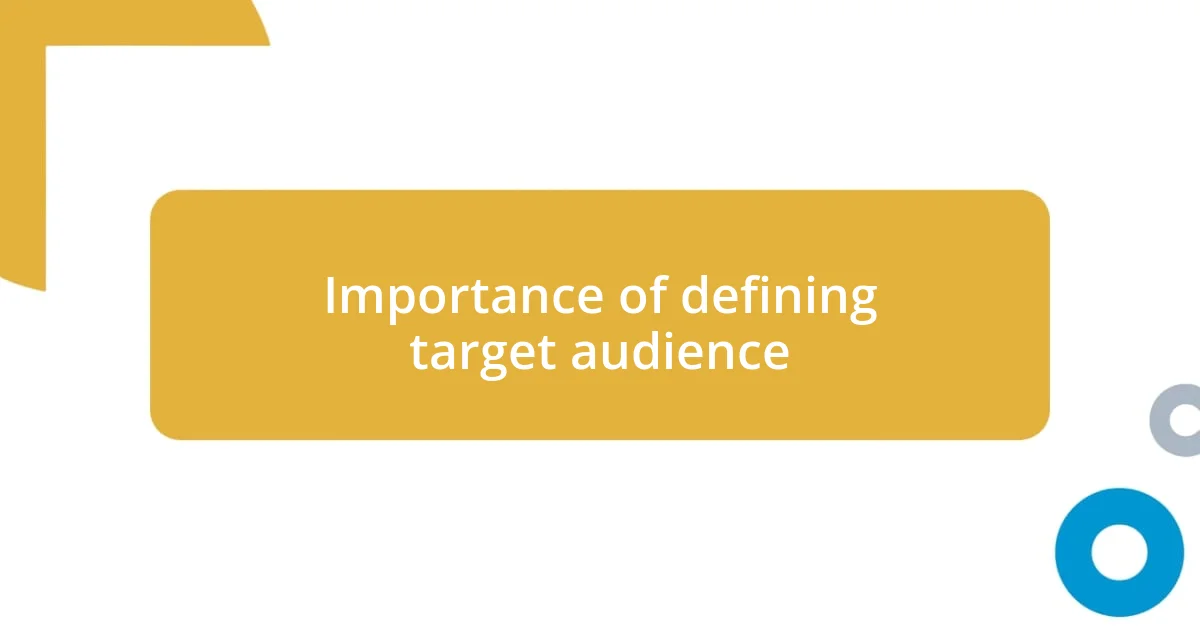
Importance of defining target audience
Defining your target audience is essential in content planning. I learned this the hard way during a project for a local coffee shop. I assumed my audience was primarily young adults, but I discovered that seniors were actually their biggest customers. This realization shifted my focus, leading to more relevant content that deeply resonated with this group.
- A clear understanding of your audience helps tailor messaging that speaks directly to their needs and wants.
- It allows for more effective resource allocation, ensuring efforts are concentrated on high-impact areas.
- Engaging with the right audience fosters a sense of community and loyalty, making your content more relatable and impactful.

Setting clear content goals
Setting clear content goals is a foundational step in my content planning journey. I often start by thinking about what I want to achieve—whether it’s increasing traffic, generating leads, or simply educating my audience. I remember when I set a goal to double my newsletter sign-ups within three months, driven by data and insights rather than just guesswork. Focusing on specific, measurable goals gave me motivation and direction.
In my experience, breaking these goals into smaller, actionable steps can make the process less daunting and more achievable. For instance, when I aimed to publish a weekly blog post, I created a checklist that included research, drafting, editing, and promotion. This approach not only kept me organized but also provided a sense of accomplishment as I ticked off each step. Have you ever found clarity in such structured plans? It’s a game changer.
Lastly, I always revisit my goals to adapt them as needed. Life happens, and sometimes priorities shift unexpectedly. I recall a campaign I planned around a specific product launch, but then unforeseen circumstances meant I had to pivot. By regularly assessing my goals, I can stay flexible and still reach my broader objectives. It makes me feel more in control of my content journey.
| Type of Goal | Description |
|---|---|
| SMART Goals | Specific, Measurable, Achievable, Relevant, Time-bound |
| Long-term Goals | Vision-based, set for the future (e.g., becoming a thought leader) |
| Short-term Goals | Immediate targets that contribute to long-term goals (e.g., publish 2 articles this month) |
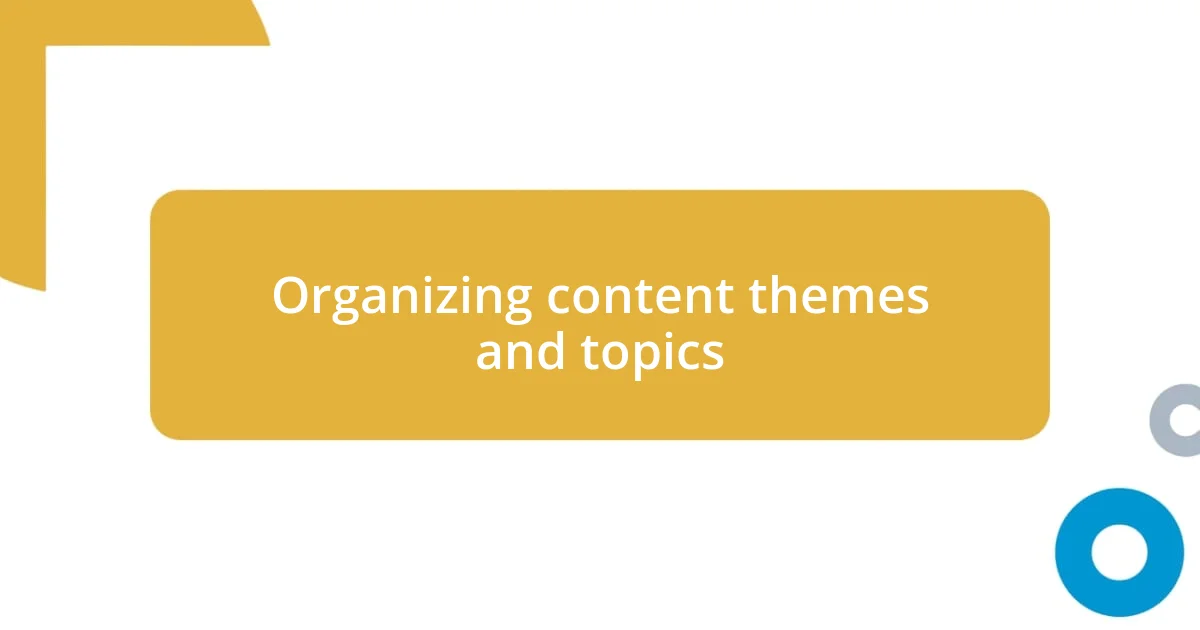
Organizing content themes and topics
Organizing content themes and topics is a process that transforms creativity into direction. I often start by brainstorming broad themes that resonate with my audience. Once I’ve mapped out these themes, like lifestyle tips or industry trends, I dig deeper and break them into specific topics. This method brings clarity and keeps my content aligned with my goals. Have you tried separating your overarching themes in this way? It’s like untangling a knot—once you do, everything flows more smoothly.
I remember creating a content calendar for a health and wellness blog, where I grouped topics by monthly themes. For example, January became all about “New Year, New You,” focusing on fitness and nutrition. This organization not only inspired my writing but also provided a strategic way to plan social media campaigns around those themes. The excitement that came from seeing the entire month laid out was fulfilling and kept my motivation alive. Isn’t it refreshing to visualize your content in such a structured manner?
Finally, I often revisit and tweak these themes based on audience feedback and analytics. For instance, after noticing a spike in engagement with mental health topics, I decided to incorporate a series dedicated to “Mindfulness Mondays.” This instant connection made my planning feel more organic and responsive. What about you? How do you adjust your content themes to stay in touch with your audience’s evolving interests? It’s all about maintaining that dialogue and ensuring your content remains relevant and engaging.
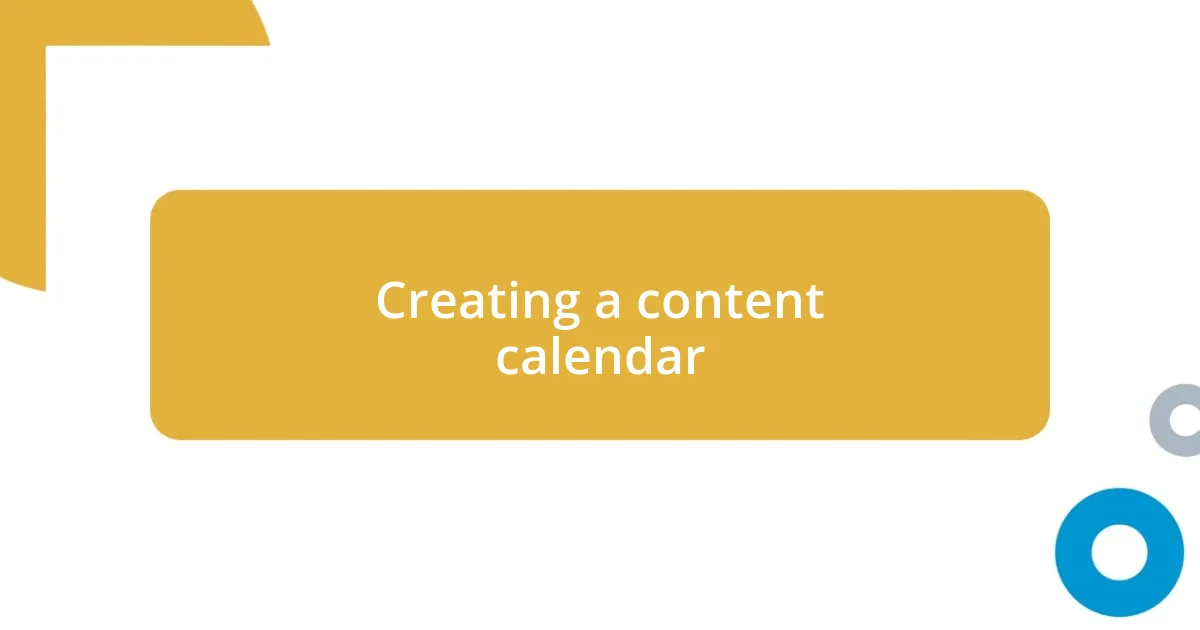
Creating a content calendar
Creating a content calendar is a bit like drafting a blueprint for a building; it gives structure to your creative ideas. Personally, I prefer to use a digital tool for this—something visually friendly, like Google Sheets or a project management app. This way, I can easily move things around, ensuring that each piece of content serves a purpose in the overall strategy. Don’t you find it exhilarating to see your ideas laid out in front of you?
I vividly remember the first time I meticulously planned a quarter’s worth of content. I marked important dates, holidays, and any industry events that could influence my themes. The thrill came when I realized how much easier it was to stay on track and stay inspired. At that point, I could channel my creativity toward crafting captivating narratives rather than scrambling to come up with ideas the night before. Have you ever felt that rush of clarity when everything is in order? It’s like a breath of fresh air.
What’s even more rewarding is looking back at what I’ve planned and knowing that I can adjust the calendar as needed. For example, when a sudden opportunity arose to collaborate with an influencer, I shifted my schedule to accommodate new content. It felt empowering to be able to adapt without losing sight of my goals. Flexibility in my content calendar has turned into one of my favorite strategies. It’s all about striking a balance—how do you incorporate spontaneity into your structured planning?

Tools for effective content planning
When it comes to tools for effective content planning, I often find myself drawn to Trello. Its visual card layout helps me manage various stages of content development seamlessly. I remember a time when I juggled multiple campaigns simultaneously; using Trello allowed me to keep track of content deadlines, brainstorm ideas, and even collaborate with team members effortlessly. Have you ever experienced the chaos of too many tabs open? Sometimes, a simple tool can eliminate that overwhelm and provide clarity.
Another tool that I swear by is Evernote. It’s a digital notebook that lets me capture ideas anywhere, anytime. I’ve had moments of inspiration catch me off guard—like when I was cooking and suddenly thought of a compelling blog post. The ability to jot down thoughts quickly saves those fleeting ideas from slipping away. Don’t you love the thrill of capturing creativity in the moment? Evernote becomes my trusty companion in those instances.
Lastly, Google Analytics plays a crucial role in my planning process. It gives me insight into what’s resonating with my audience, which allows for data-driven adjustments. I recall a particular moment when I noticed a high bounce rate on a specific topic. It prompted me to rethink how I approached similar content, ultimately enhancing my engagement. Isn’t it fascinating how data can guide our creativity? Aligning my content with proven audience preferences has proven to be a game changer.
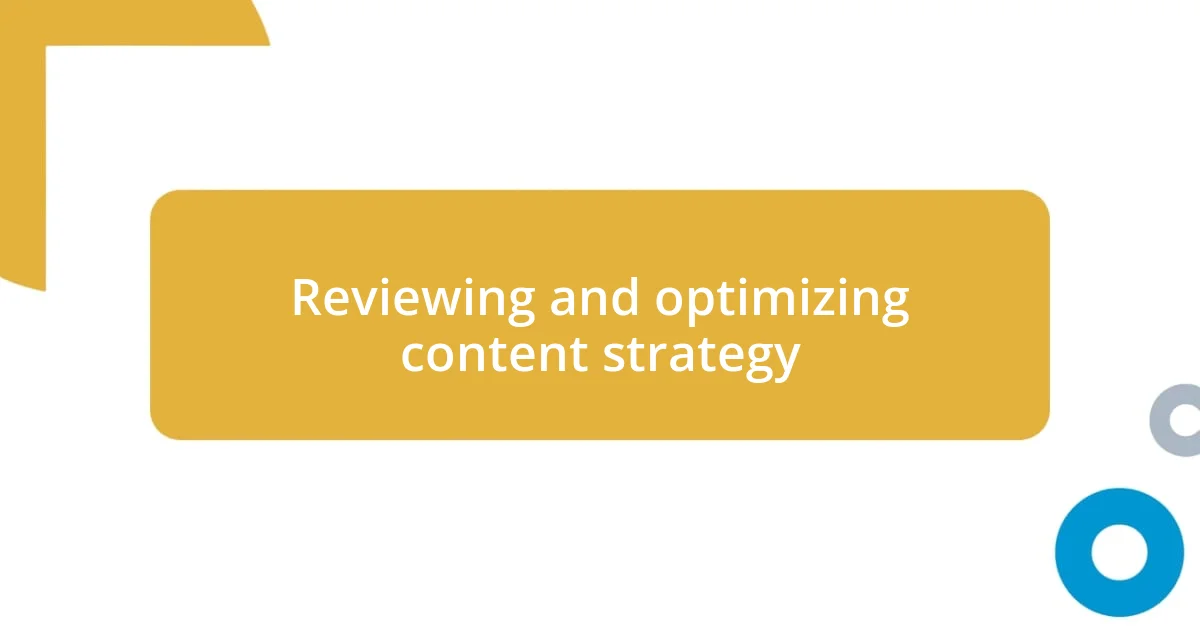
Reviewing and optimizing content strategy
Reviewing and optimizing my content strategy is a continuous journey that requires both reflection and adaptability. I make it a point to regularly analyze the performance of my content—looking closely at metrics like engagement rates and shares. One time, I noticed an article I had high hopes for fell flat. It was a tough pill to swallow, but it became an opportunity to dig deeper into my audience’s preferences. Reflecting on this experience allowed me to pivot and tailor future content more strategically. Have you ever had that lightbulb moment after analyzing something that didn’t work?
In addition to data analysis, I actively seek feedback from peers and my audience. This two-way communication has opened my eyes to blind spots I might have missed on my own. For instance, after posting an article, I invited readers to share their thoughts, and the insights were invaluable. I remember one comment that completely reshaped my perspective on a topic, invigorating my next piece. How often do we overlook the voice of our audience in our strategy?
Moreover, I believe in the power of staying curious and exploring new content formats. One day, I decided to experiment with video content, even though I was nervous about stepping out of my comfort zone. The response was overwhelmingly positive, and that experience taught me the importance of embracing change. Isn’t it thrilling to discover new avenues for creativity and connection? Each time I optimize my strategy, I feel reinvigorated, eager to keep pushing boundaries.












